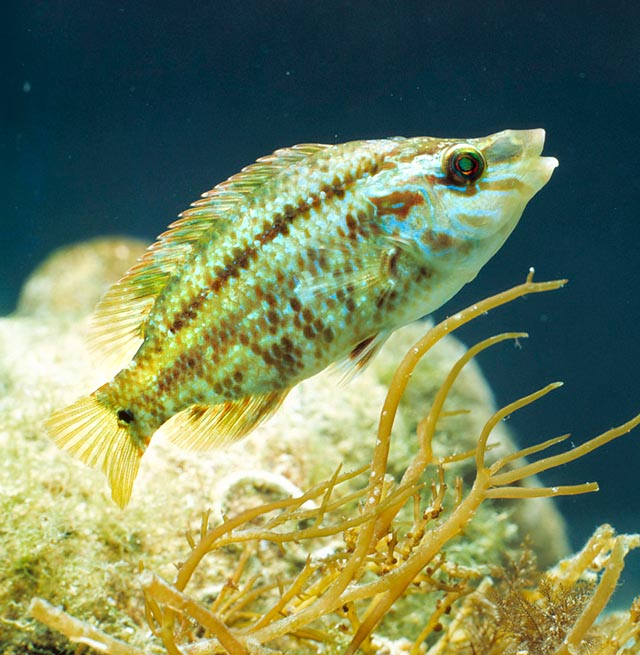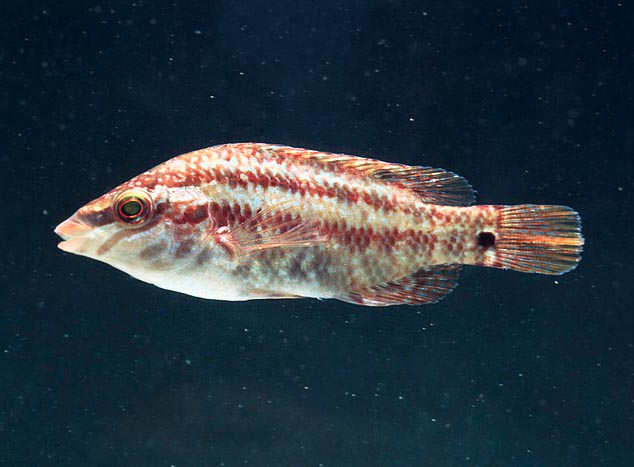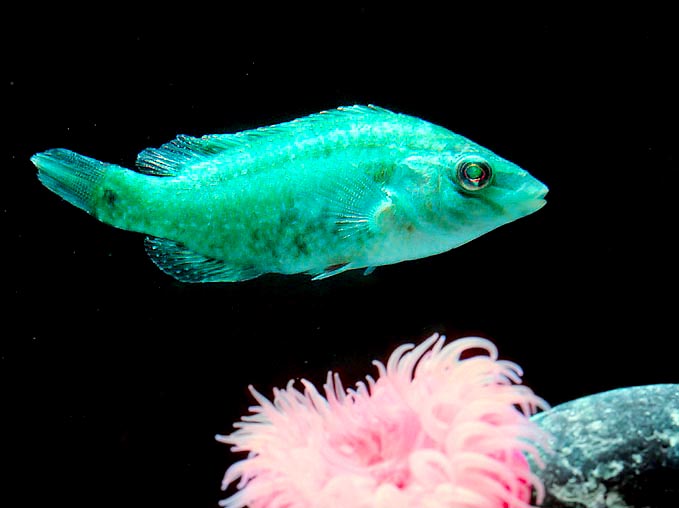Family : Labridae

Text © Giuseppe Mazza

English translation by Mario Beltramini

The Five-spotted wrasse (Symphodus roissali) lives in the Mediterranean backwash zone © Giuseppe Mazza
The name of the genus comes from the Greek “syn” = together and “odous” = teeth, therefore, teeth grown together, which are almost unseen, hidden by the gingival tissue and by the lips.
The name of the species “roissali” means “Roissal’s”; that is, it was honoured to the Niçois painter Clément Honoré Claude Roassal, called also Roissal (1781-1850).
For various aspects, it is much similar to the Symphodus ocellatus, so that they had been talking of a Symphodus ocellatus var. quinquemaculatus (from the synonym, nowadays obsolete of Crenilabrus quinquemaculatus) but then, after having evaluated all the elements, the thing has recessed and the Crenilabrus quinquemaculatus, nowadays Symphodus roissali, is considered as a good species.
Zoogeography
The five-spotted wrasse is present all over the Mediterranean, Black Sea included, but even beyond the Gibraltar Strait, on the Moroccan, Spanish Atlantic coasts as well as on the French ones up to Brittany.
Ecology-Habitat
It lives, solitary, in shallow waters, in the backwash zone at less than one metre of depth, even if, at times, it can be found in deeper waters. Being frightful, it loves the rocky coasts, full of ravines, but it does not ignore completely the seagrass meadows. More than swimming, it spends the day moving quickly from a hiding place to another.

Usually is of 8-12 cm and the most frequent livery is reddish in spite of its Italian name © Giuseppe Mazza
Usually, the males measure from 8 to 12 cm, but they have caught specimens even of 15-17 cm. The females are smaller.
The body is much higher than that of the Symphodus ocellatus .
For the rest, also here there is only one dorsal, spiny in the first part and formed than by soft rays, like the anal. Caudal spatulate fin, almost quadrangular, rounded pectoral and modest ventral ones.
The head is conical, with little retractile mouth and upper jaw slightly longer.
The operculum has a cutaneous tiny tongue.
The colour varies depending on the sex, the size, the season and the environment, but there are no rules.
In fact, in the same spot and in the same season, we can see, at the same time, irrespective of the size, the most disparate colours.
Most of the specimens show a reddish livery, but in harmony with the Italian name (“tordo verde” = green wrasse), which recalls the green colour, there are also several olivaster ones, and some of them are even of an emerald green colour.
The dark spots remain, forming, more or less, two bands on the sides, but also these ones may disappear or suddenly intensify, depending on the mood of the fish and like Symphodus ocellatus, there is a dark spot in the middle of the caudal peduncle.

Rare emerald units do exist and the dots fade after their mood © Giuseppe Mazza
The five-spotted wrasse nourishes mainly of molluscs, annelids and crustaceans, but also of bryozoans and echinids.
By the beginning of summer, as for the Symphodus ocellatus , the males build some small nests, cup-shaped, with seaweeds and sand.
Usually, they work during the warmest hours of the day at only 15-70 cm of depth, often contenting them of completing, with some vegetal shred mixed with sand, the suitable troughs they discover between the rocks.
The eggs are sticky. The male fecundates them and then stands the watch till the hatching, with the head up in an oblique position, ventilating them with the tail for ensuring better ventilation.
It has been noted that the five-spotted wrasses are very attached to their small territory, of which they know resourced and hiding places and often they maintain it for one year. The vulnerability index of this species is of 31 over 100.
Synonyms
Crenilabrus aeruginosus Pallas, 1814; Crenilabrus arcuatus Risso, 1827; Crenilabrus capistratus Pallas, 1814; Crenilabrus quinquemaculatus Risso, 1827; Crenilabrus roissali Risso, 1810; Crenilabrus tigrinus Risso, 1827; Labrus aeruginosus Pallas, 1814; Labrus capistratus Pallas, 1814; Labrus oculusperdix Rafinesque, 1810; Lutjanus alberti Risso, 1810; Lutjanus roissali Risso, 1810; Symphodus quinquemaculatus Risso, 1827.
→ For general information about FISH please click here.
→ For general information about BONY FISH please click here
→ For general information about CARTILAGINOUS FISH please click here.
→ To appreciate the BIODIVERSITY of BONY FISH please click here.
→ To appreciate the BIODIVERSITY of CARTILAGINOUS FISH please click here.
